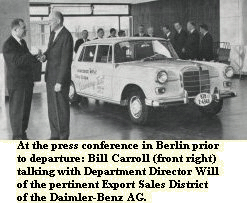 Berlin was the start, Paris
the finish. The distance in-between amounted to 4,043 miles (6.468 km), along which the
well-known American journalist Bill Carroll conducted an economy test in a Mercedes-Benz
diesel passenger car. Berlin was the start, Paris
the finish. The distance in-between amounted to 4,043 miles (6.468 km), along which the
well-known American journalist Bill Carroll conducted an economy test in a Mercedes-Benz
diesel passenger car.
Following the successful conclusion of the run, but also at the intermediate stops in
Stuttgart, Geneva, Milan, Rome, Venice, Nice Barcelona, Saragossa, Madrid, Andorra - the
international press celebrated the enterprise as a "Triumph of a matured
automobile". Mr. Caroll has proven - and the large number of American tourists who
pick up their cars each year at the Sindelfingen plant of the Daimler-Benz AG will no
doubt acknowledge - that there is hardly a more pleasant, nor a more economic possibility
of going on an extended holiday trip.
|
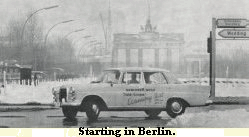 When we talked to the likable
journalist and his charming wife at the end of his trip in Paris, Bill Caroll emphasized
that he owes his travel impressions mainly to "traveling in his vehicle".
"Well", he said, "we Americans, and believe me I can say the same more or
less about all tourists, are today no longer concerned to arrive at our holiday goal as
quickly as possible. After all, holidays begin when you start your trip and in my opinion
you can simply never learn enough about a foreign country. This is why I consider
traveling in one's own car the best method to gain new impressions mile fo rmile. And the
ideal vehicle for such a purpose is the 190D, since you hardly travel at lower costs and
simultaneously at similar comfort with any other means of transportation." When we talked to the likable
journalist and his charming wife at the end of his trip in Paris, Bill Caroll emphasized
that he owes his travel impressions mainly to "traveling in his vehicle".
"Well", he said, "we Americans, and believe me I can say the same more or
less about all tourists, are today no longer concerned to arrive at our holiday goal as
quickly as possible. After all, holidays begin when you start your trip and in my opinion
you can simply never learn enough about a foreign country. This is why I consider
traveling in one's own car the best method to gain new impressions mile fo rmile. And the
ideal vehicle for such a purpose is the 190D, since you hardly travel at lower costs and
simultaneously at similar comfort with any other means of transportation."
|
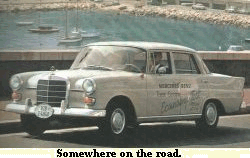 At the end of the trip 50
leading representatives of the French dailies and the trade press met in the exclusive
Paris restaurant "Le Doyen" for an oppurtunity of discussing all the details of
this Trans-Europe Economy Test. Following the introductory words of Monsieur Ch.
Delecroix, the Mercedes-Benz general distrubitor for France, Departement Director Heinrich
Will, Head of the Sales Range North America, referred in the name of the Daimler-Benz AG
a.o. to the advantages obtained by American tourists when buying a Mercedes-Benz vehicle
in Germany, a fact again proven by the economy run of Mr. Caroll. At the end of the trip 50
leading representatives of the French dailies and the trade press met in the exclusive
Paris restaurant "Le Doyen" for an oppurtunity of discussing all the details of
this Trans-Europe Economy Test. Following the introductory words of Monsieur Ch.
Delecroix, the Mercedes-Benz general distrubitor for France, Departement Director Heinrich
Will, Head of the Sales Range North America, referred in the name of the Daimler-Benz AG
a.o. to the advantages obtained by American tourists when buying a Mercedes-Benz vehicle
in Germany, a fact again proven by the economy run of Mr. Caroll.
|
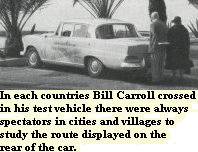 He stressed the fact that by picking up their
Mercedes-Benz diesel passenger car in Europe Amercian tourists would make savings which
then could be used for paying a part of their hotel and travelling costs. In closing he
referred to the also successfully competition between a Mercedes-Benz 190D and the French
express train running on schedule between Paris and Nice, organized by the Mercedes-Benz
general distrubitor. He called the event worthy of the fact that with a Mercedes-Benz
diesel vehicle you are not only traveling faster, but also cheaper than with an express
train. He stressed the fact that by picking up their
Mercedes-Benz diesel passenger car in Europe Amercian tourists would make savings which
then could be used for paying a part of their hotel and travelling costs. In closing he
referred to the also successfully competition between a Mercedes-Benz 190D and the French
express train running on schedule between Paris and Nice, organized by the Mercedes-Benz
general distrubitor. He called the event worthy of the fact that with a Mercedes-Benz
diesel vehicle you are not only traveling faster, but also cheaper than with an express
train.
|
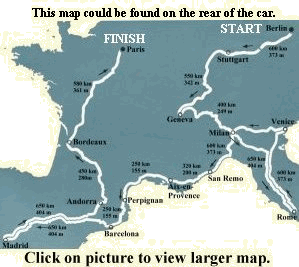 It
was a happy coincidence that the two events could be celebrated in "Le Doyen" in
the French capital city. And both the French press and the public showed their
appreciation by displaying their pertinent interest. Everybody was very much aware of the
fact that none of the vehicles has been equipped with any special technical equipment and
that they were in fact vehicles "the way they are bought by the customers". It
was a happy coincidence that the two events could be celebrated in "Le Doyen" in
the French capital city. And both the French press and the public showed their
appreciation by displaying their pertinent interest. Everybody was very much aware of the
fact that none of the vehicles has been equipped with any special technical equipment and
that they were in fact vehicles "the way they are bought by the customers".
Mr. Carroll proved on his 4,043 miles that with the 190D Mercedes-Benz drivers are in
command of a vehicle which uses only 6,85 liters diesel fuel for each 100km (35 miles per
US gallon) on the entire route. "That", Bill Carroll said, "is absolutely
unique for a vehicle in this class, more so since during the ride Alpine passes, normal
highways and unmetaled roads had to be covered."
|
The journey was Mr. Carroll's third trip with a Mercedes-Benz vehicle
within 6 years. "But", he said in closing. "It was also the most impressive
one and the most thrilling. Automobile tourism of today in its most beautiful
aspects."
(From an article in a specially printed Mercedes-Benz brochure) |

![]()
![]()
